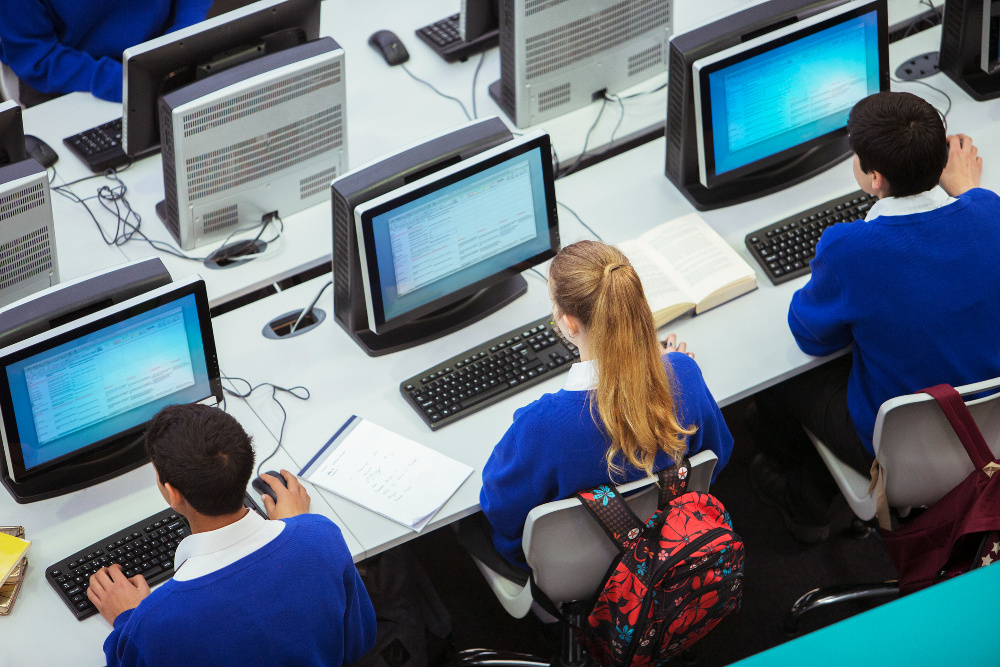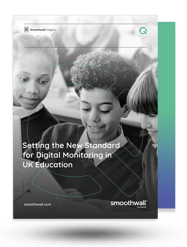In order to meet Keeping Children Safe in Education guidance, schools are required to have “appropriate filtering and monitoring systems in place” (KCSIE 2024, section 140). Smoothwall has been serving UK schools, colleges and MATs for over 20 years. Our collaborative efforts with these organisations have been instrumental in refining and perfecting digital monitoring technology, forging a powerful partnership aimed at enhancing student safety and wellbeing.
We’ve distilled insights from this long journey of learning and adaptation into eight comprehensive standards for digital monitoring which schools can readily adopt. These standards empower schools to navigate the complex landscape of digital safety and student wellbeing with confidence, whilst avoiding the most common pitfalls and challenges.
8 standards for digital monitoring excellence
1. Meet legislation
It is essential for schools to implement a monitoring strategy that not only ensures the online safety of their students, but complies with statutory guidelines.
According to the UK Safer Internet Centre’s (UKSIC) Appropriate Monitoring for Schools 2024 guide, schools, colleges and MATs should “be satisfied that their monitoring strategy or system (including keywords if using technical monitoring services) at least covers the following content: illegal, bullying, child sexual exploitation, discrimination, drugs/substance abuse, extremism, gambling, hate speech, pornography, self-harm, violence and suicide.”
Schools should also consider how their monitoring system integrates with their policies and satisfy themselves to the extent that their monitoring strategy meets the required principles.
Compliance with these obligations can help schools identify any safeguarding and wellbeing issues at an early stage, creating a safer learning environment. Additionally, substantial evidence gathered through monitoring can serve as a compelling demonstration of a school’s commitment to safeguarding students - a positive and contributing factor when it comes to Ofsted inspections.
Failure to comply can place student wellbeing at risk, disrupt education, damage the school’s reputation and in some cases, lead to legal consequences.
2. 24/7/365 human moderation
Whether you choose to moderate internally or have an external provider do it for you, the importance of 24/7/365 human moderation cannot be overstated. In fact, when it comes to the detection of safeguarding incidents beyond the school premises and outside of regular school hours, it’s crucial.
According to Smoothwall data, in the space of 12 months, 92,964 incidents were recorded outside of school premises, some of which resulted in a telephone call to a DSL for immediate intervention.
We know that schools rarely have the time or capacity to thoroughly analyse the amount of digital content students encounter. Human moderators possess a unique advantage, as they often monitor risks up and down the country, and even around the world. This broader perspective enables them to identify emerging trends and potential dangers that individual schools might overlook.
3. 24/7 device monitoring

With an increasing number of students now taking school devices home, extending protection beyond school hours is paramount.
Monitoring devices 24/7 provides an extra robust safety net for schools. Education settings that adopt this method gain the reassurance that even during nonschool hours, they can detect and respond to any serious safeguarding incidents or concerning student online activity, before it’s too late.
It’s a proactive approach, enabling schools to be well-informed and prepared to take immediate action should a serious incident occur. Without it, schools risk overlooking critical safeguarding and wellbeing issues that could emerge - leaving students unprotected and vulnerable to harm.
4. Non-web browser monitoring
Smoothwall data shows that 1 in 3 monitoring alerts happen offline.
Whether it’s a Microsoft document, chat software or gaming app, more and more students are using these platforms as a way to circumvent monitoring, or worse still, as a cry for help.
Schools who do not monitor offline applications could be missing vital information which would suggest a student is in urgent need of care and support.
5. Comprehensive reporting
Comprehensive reporting is an indispensable asset for schools when it comes to monitoring students’ activities. In fact, it has multiple purposes:
-
It plays a pivotal role in meeting regulatory requirements, providing schools with the evidence needed for assessments by bodies such as Ofsted and the Independent Schools Inspectorate (ISI).
-
It helps to reduce reliance on IT support, granting DSLs the autonomy to access critical reports independently. This not only streamlines the monitoring process, but also enables DSLs to swiftly identify and respond to potential issues.
- By aggregating and analysing data over time, DSLs can spot any concerning trends and patterns in student behaviour. This invaluable insight aids safeguarding and helps to inform educational strategies - a function used particularly well across MATs.
Experience tells us that schools relying on a more standard type of reporting risk compromising the overall effectiveness of their safeguarding efforts. Suffering from a level of data blindness, schools and their DSLs can miss valuable insights and patterns of behaviour, which in turn can impede their ability to provide support and safeguarding education to students.
Moreover, it can result in operational inefficiencies. DSLs may become dependent on IT support for generating ad-hoc reports, placing a burden on already overstretched workloads and diverting resources away from other essential tasks.
6. Scalability

Our extensive experience collaborating with MATs and multi-site organisations tells us that scalability isn’t a nice to have, it’s a necessity. As the number of sites within a trust grows, so do the risks, and so does the need for technologies such as digital monitoring.
In 2022, the Department for Education set out a new initiative for all schools across the UK to be in, or in the process of joining a trust, by 2030. This mandate has only intensified the requirement for MATs to adopt a strategic approach which allows them to streamline digital monitoring technology across multiple school sites, in a timely and effective way, and with minimum impact on their network.
Choosing a solution which offers a multi-tenant view can help. Not only can it enable MATs to facilitate swift and convenient data sharing among DSLs and other key stakeholders, but it also acts as a formidable barrier against unauthorised access to sensitive information, helping to preserve data integrity and security.
Additionally, it allows for the exchange of educational insights and best practices, contributing towards a more effective learning environment across the whole trust.
The repercussions of not harnessing scalability can be profound and far-reaching. Without the capacity to scale, schools risk losing out on key information and intelligence across their trust, potentially leading to operational inefficiencies, compliance issues and an unnecessary drain on resources.
7. Integration into record management systems
Our experience working with schools highlights the importance of integration when it comes to student digital safety and overall risk management. Schools who introduce a siloed approach to safeguarding can often find themselves grappling with a myriad of challenges, including:
- Missed early warning markers
- Poor communication
- Overwhelmed staff
This fragmented approach can result in disjointed data, making it difficult to gain a comprehensive understanding of student safety and wellbeing.
Schools who choose to prioritise integration between digital monitoring and their existing record management systems can benefit from a significant advantage. It creates a unified ecosystem where information can flow seamlessly between platforms - providing DSLs with a real-time, holistic view of any challenges or issues students may be facing. With this, schools are able to promptly address these concerns and use these insights to make referrals to third party authorities where necessary, whilst elevating school-wide educational strategies.
8. Timely deployment
We know that schools do not have the time or resources to squander on prolonged implementation processes. When deployment isn’t streamlined, it can have a detrimental impact. For example, in some cases, lengthy and cumbersome implementation processes can result in DSLs and other safeguarding staff having to spend more time than necessary focusing on the solution.
Time-consuming deployment processes can also deter stakeholders from fully buying into a solution. The result is often resistance and a slower realisation of the solution’s potential benefits.
When deployment is executed with precision and efficiency, the benefits are manifold. A swift and seamless implementation not only minimises disruption, but also fosters a sense of confidence and enthusiasm among stakeholders.
In turn, vulnerable students can be spotted much sooner, with schools able to demonstrate their commitment to staying ahead of safeguarding challenges and the ever-changing digital landscape.
By embracing these standards, schools can anticipate cost savings, expedited identification of vulnerable, at-risk students and a safer, more nurturing digital environment where students can thrive.

Want to learn more?
To learn more about effective digital monitoring in UK schools, colleges and MATs, download our whitepaper: Setting the New Standard for Digital Monitoring in UK Education
Alternatively, if you would like to find out more about Smoothwall Monitor, please get in touch via enquiries@smoothwall.com. We’d be happy to help.
Download now




